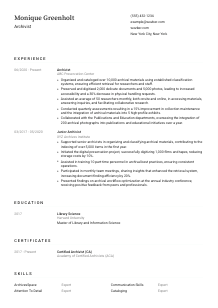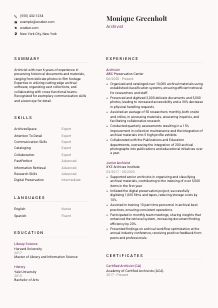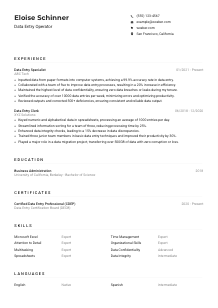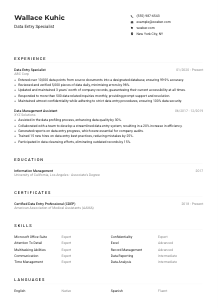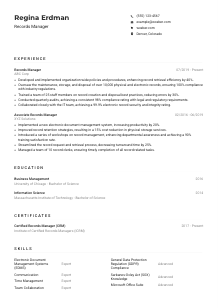Archivist Resume Example
Preserving history, but your resume feels ancient? Delve into this Archivist resume example, constructed with Wozber free resume builder. See how effortlessly you can catalog your archival expertise to align with modern job records, and rewrite your career narrative for its rightful place in the annals of success!
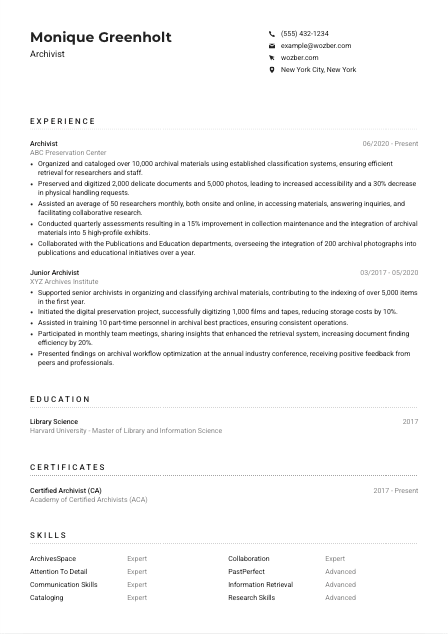
How to write an Archivist Resume?
Embarking on the quest to land your dream Archivist position? Your resume is the key that unlocks the door to your future. With a blend of ancient treasures and modern digital tools, you're tasked with preserving history. But is your resume stuck in the past?
Fear not! Using Wozber, the free resume builder, and leveraging our dedicated guide, you'll craft a resume that not only matches the job description to a 'T' but also sails through Applicant Tracking Systems (ATS) with ease. Let's roll up our sleeves and dive into the world of archives, ensuring your resume is a treasure map leading directly to job success.
Personal Details
First impressions are everything, especially when it comes to your resume. The Personal Details section sets the stage for your entire application. To ensure you stand out for your Archivist position, follow these specialized steps to tailor this section for maximum impact.
1. Your Name: The Title on Your Tome
Your name is the banner under which your professional achievements march. Ensure it's prominently displayed with a legible font, possibly a touch larger than the rest of the text to make it stand out. This isn't just a name; it's the label on your legacy.
2. Job Title: Donning Your Archivist Cap
"Archivist" - Seeing your desired job title right beneath your name aligns you immediately with the role, telling the hiring manager, "This is the person you've been searching for." It's a subtle, yet powerful way to position yourself.
3. The Essentials of Contact
Accuracy is key in archiving, as it is with your contact information. Include your phone number and a professional email address. A mix-up here could mean a missed connection. Consider using a format like firstname.lastname@email.com for a touch of professionalism.
4. Location: Rooting Yourself in Relevance
Mentioning "New York City, New York" verifies that you're in the heart of action, ready and available, eliminating any doubts about relocation or availability. It's about making it clear: you're here, you're ready.
5. Online Presence: A Gateway to Your Professional World
A LinkedIn profile can serve as an expansion of your resume. It's a chance to show a dynamic version of your professional story, with recommendations, endorsements, and more. Ensure it's up-to-date to complement your resume perfectly.
Takeaway
Think of the Personal Details as the prelude to your professional story. Get these elements right, and you've set the stage for a compelling read. With everything aligned, you're not just another applicant; you're a front-runner.





Experience
The Experience section is where you showcase the depth and breadth of your archival journey. It's more than a list; it's a narrative of your development, achievements, and the value you've brought to previous roles. Here's how to tailor this section, ensuring it resonates with your desired Archivist role.
- Organized and cataloged over 10,000 archival materials using established classification systems, ensuring efficient retrieval for researchers and staff.
- Preserved and digitized 2,000 delicate documents and 5,000 photos, leading to increased accessibility and a 30% decrease in physical handling requests.
- Assisted an average of 50 researchers monthly, both onsite and online, in accessing materials, answering inquiries, and facilitating collaborative research.
- Conducted quarterly assessments resulting in a 15% improvement in collection maintenance and the integration of archival materials into 5 high‑profile exhibits.
- Collaborated with the Publications and Education departments, overseeing the integration of 200 archival photographs into publications and educational initiatives over a year.
- Supported senior archivists in organizing and classifying archival materials, contributing to the indexing of over 5,000 items in the first year.
- Initiated the digital preservation project, successfully digitizing 1,000 films and tapes, reducing storage costs by 10%.
- Assisted in training 10 part‑time personnel in archival best practices, ensuring consistent operations.
- Participated in monthly team meetings, sharing insights that enhanced the retrieval system, increasing document finding efficiency by 20%.
- Presented findings on archival workflow optimization at the annual industry conference, receiving positive feedback from peers and professionals.
1. Decoding Job Necessities
Pour over the job description like an ancient manuscript, identifying and underlining keywords and responsibilities. These are your clues to align your experience with what your future employer seeks.
2. Chronology of Contributions
List your roles, starting with the most recent. For each position, include the job title, company name, and dates of employment. This structure not only highlights your journey but also showcases your ascent in the archival field.
3. Tailored Tales of Achievement
For each role, craft bullet points that reflect your accomplishments, especially those mirroring the job description. Did you digitize a rare collection? Or perhaps you improved a cataloging system? These are the stories that set you apart.
4. The Power of Numbers
Quantify your impact wherever possible. Whether it's the number of items cataloged or the percentage by which you reduced retrieval times, these figures transform your achievements from abstract to concrete.
5. Relevance is Key
Focus on the experiences that directly relate to your desired Archivist role. As fascinating as unrelated achievements might be, they can distract from your goal. Keep your narrative focused and on-point.
Takeaway
Your Experience section is your professional story. Make it compelling, relevant, and rich with achievements that speak directly to the role. With each bullet point, you're not just listing what you did; you're showcasing how invaluable you will be in your next role as Archivist.
Education
In the realm of Archivist roles, your educational background is not just a formality - it's the bedrock of your expertise. Positioning this section thoughtfully can underscore your qualifications and readiness for the role. Walk through these steps to refine this essential component.
1. Identify Educational Cornerstones
The job description specifies a "Bachelor's degree in Library Science, History, or a related field." Ensure your education aligns prominently with this, positioning relevant degrees front and center.
2. Clear, Concise Layout
Present your educational background in a straightforward format: degree, field of study, institution, and graduation date. This clarity lets the hiring manager quickly ascertain your qualifications.
3. Degree Specifics Matter
For roles like ours, detailing your degree matters. Highlighting a "Master of Library and Information Science" and a "Bachelor of Arts in History" directly connects your academic achievements with the job's requirements. It's about showcasing perfect alignment.
4. Coursework and Specializations
Though not always necessary, mentioning specialized courses or projects can enrich your profile, especially early in your career. Did you complete a notable thesis or project in archival science? This could be the detail that intrigues a hiring manager.
5. Other Academic Honors
Did you graduate with distinction or hold a significant role in a university's historical society? These achievements hint at your dedication and passion, elements that are irresistible to prospective employers.
Takeaway
Your Education section is more than just dates and institutions; it's a testament to your preparedness for the Archivist role. Craft it to showcase not just your qualifications, but also your dedication to the field of archiving.
Certificates
In the world of archiving, continuous learning sets you apart. Certifications can be powerful indicators of your commitment and expertise. Let's navigate through how to highlight these accomplishments effectively.
1. Scan for Relevance
Review the job posting for any preferred or required certifications. While our targeted job description may not specify them, including certifications like "Certified Archivist (CA)" directly showcases your dedication to professional growth.
2. Prioritize Impact
Select certifications that underscore your qualifications for the Archivist role. Listing relevant certifications first not only optimizes your resume for ATS but also ensures that hiring managers notice your most pertinent qualifications immediately.
3. Dates Tell a Story
Include the acquisition or renewal dates of your certifications. This shows not only your initial qualification but also your ongoing commitment to staying current in your field.
4. Continuous Learning
The archival field, like many others, evolves constantly. Highlighting recent certifications or those in progress demonstrates your proactive approach to professional development, making you a more attractive candidate.
Takeaway
Think of each certificate as a chapter in your professional story that highlights your commitment to excellence in the archival field. It's not just about what you've learned; it's about showcasing your journey of continuous improvement and dedication.
Skills
Skills are the nuts and bolts of your resume, the hard evidence of your ability to excel in an Archivist role. Here's how to curate this section to clearly communicate your mastery and adaptability in the dynamic field of archiving.
1. Unearth the Essentials
Carefully read through the job description to identify the key skills required. For our Archivist role, "knowledge and proficiency in archival software and systems" such as "ArchivesSpace" or "PastPerfect" are paramount. These should be prominently featured.
2. A Showcase of Strengths
Align your own skills with those listed in the job description. Highlight your expertise in areas like "Cataloging," "Collaboration," and "Digital Preservation." This is your chance to show you speak the same professional language.
3. Order and Precision
List your skills in order of relevance to the Archivist position, starting with those most critical. This organized approach ensures the hiring manager sees your most applicable skills first, presenting you as the ideal match.
Takeaway
Your Skills section paints a picture of your professional capabilities. Select and order each skill with care, ensuring the hiring manager can immediately grasp your expertise and potential fit for the Archivist position. Your skills are your armor; make them shine.
Languages
In our interconnected world, the ability to communicate across cultures can be a distinct advantage, even in archival roles. Here's how to leverage your linguistic skills to stand out.
1. Align with Job Specifications
"Proficiency in English is a significant asset." If the job values language skills, ensure yours are prominently listed, starting with those specifically mentioned in the job description.
2. Your Linguistic Landscape
Beyond the essentials, include other languages you're proficient in. Even if not directly relevant, they demonstrate versatility and adaptability—traits that are valuable in any role.
3. Clarity in Proficiency
Clearly indicate your level of proficiency for each language listed. Use terms like 'Native,' 'Fluent,' 'Intermediate,' and 'Basic' to provide a transparent snapshot of your abilities.
4. Tailor to the Role
Consider the broader context of the Archivist position. If it involves international collections or collaboration, emphasizing your language skills can underscore your readiness to engage with diverse materials and colleagues.
5. Embrace Your Global Perspective
Each language you speak opens another door to understanding the world's archives. Highlight your languages not just as skills, but as pathways to global knowledge and connections.
Takeaway
Your ability to speak multiple languages is a testament to your ability to connect and communicate in a global field. Showcase this skill set as part of your unique professional identity, enriching your application and expanding your potential contribution as an Archivist.
Summary
Your summary is the opening paragraph of your professional story, setting the stage for what's to come. Here's how to craft a compelling prologue that captures the essence of your candidacy for the Archivist position.
1. Embrace Your Archivist Identity
Start with a strong statement that encapsulates your professional stance. For example, "Archivist with over 6 years of experience in preserving historical documents" instantly frames you as an experienced and focused candidate.
2. Mirror the Mission
Highlight your skills and achievements that directly align with the job's requirements. This is your chance to show you're not just any candidate; you're the perfect puzzle piece for their specific needs.
3. Conciseness is Key
Your summary should be a tight, impactful teaser of your qualifications and potential contributions. Aim for 3-5 lines that leave the hiring manager eager to learn more about you.
4. Set the Tone
Your summary is both an introduction and an invitation. Craft it to reflect your professionalism, dedication, and excitement for the opportunity. It's the first glimpse into your potential future with the organization.
Takeaway
The summary sets the tone for your resume, inviting the reader into your professional narrative. Make it captivating, make it reflective of your archivist prowess, and most importantly, make it yours. This is your opening chapter - make it resonate.
Embarking on Your Archivist Voyage
With these guidelines, you're equipped to assemble a resume that not only showcases your expertise but also resonates with the specific requirements of your dream Archivist role. Utilize Wozber's free resume builder to implement these steps effortlessly, optimizing your resume with an ATS-friendly resume template and ATS resume scanner for keywords optimization. Your journey as an Archivist awaits—a journey of preservation, discovery, and contribution.
Let your resume be the map that guides you to your next great adventure. The archives are calling; it's time to answer.

- Bachelor's degree in Library Science, History, or a related field.
- Minimum of 3 years of experience in archival, preservation, or records management.
- Knowledge and proficiency in archival software and systems, such as ArchivesSpace or PastPerfect.
- Strong organizational and research skills, with meticulous attention to detail.
- Exceptional written and oral communication skills.
- Proficiency in English is a significant asset.
- Must be located in New York City, New York.
- Organize, classify, and catalog archival materials according to established criteria.
- Preserve, restore, and digitize delicate or deteriorating documents, photos, and films.
- Assist researchers, both on-site and online, in accessing materials and answering inquiries.
- Conduct regular assessments to ensure the collection is properly maintained and remains relevant to the organization's goals.
- Collaborate with other departments and stakeholders to ensure the integration of archival materials into exhibits, publications, and educational initiatives.





